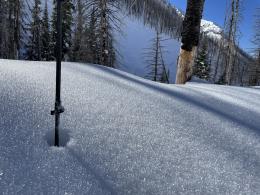Good morning. This is Dave Zinn with the Gallatin National Forest Avalanche Forecast on Monday, February 13th at 7:00 a.m. This information is sponsored by Archer Construction and World Boards. This forecast does not apply to operating ski areas.
This morning, temperatures are in the teens F near West Yellowstone and Cooke City and in the 20s F near Big Sky and Bozeman. Winds are 15-25 mph from the west to the south, and there is no new snow. Today, temperatures will be in the 20s to 30s F with 15-25 mph winds from the west to the south. Snow will arrive this evening, with 4-8” by tomorrow morning and continuing snowfall tomorrow.
In the mountains around Bozeman, Big Sky and Cooke City, human-triggered avalanches are possible on slopes where slabs of drifted snow sit on top of weak layers in the upper three feet of the snowpack. Yesterday, Doug looked for this type of instability at the Throne in the Bridger Range and found it, noting that we must be aware of wind slabs over weak layers (video). We noted similar concerns during recent field days in Hyalite Canyon and at Buck Ridge. Without significant active wind loading, you must recognize recent drifts as areas of concern by noting pillows of snow or a stiffening, hollow feel to the snow surface. Slopes below overhanging ledges of snow called cornices are likely wind-loaded. As the season progresses, cornices grow and can unpredictably collapse far from the edge. A group on Mount Blackmore got a fright when one broke near their feet this weekend (observation). Rule wind-loaded slopes out of your travel plan or dig and test for instability related to underlying weak layers.
On non-wind-loaded slopes, triggering an avalanche is unlikely. Dig down three feet and test for instability before going into avalanche terrain, carry rescue gear, expose only one team member at a time to avalanche terrain and watch partners from a safe location if they travel on steep slopes.
Today the avalanche danger is MODERATE on wind-loaded slopes and LOW on all others.
Avalanches are unlikely in the Southern Gallatin and Southern Madison Ranges and the Lionhead area, where conditions are much more stable than two weeks ago when Doug and Ian triggered an avalanche from 50 feet away (video and observation). Since then, the frequency of slides has decreased. One week ago, riders noted a natural avalanche on the west face of Sage Peak in the Taylor Fork (observation). A day later, an avalanche on Two Top partially buried a sled (observation). And the last reported avalanche from the area occurred on Thursday near Tepee Basin when a rider triggered an avalanche on a small slope (observation). Riding at Lionhead on Saturday, Alex noted improved stability (video).
While conditions are generally safe, adhere to the fundamentals of avalanche safety because certainty is impossible to come by in steep, snow-covered mountains. Dig three to four feet deep and test weak layers for isolated areas of instability, carry rescue gear and expose only one team member at a time to avalanche terrain while watching partners from safe locations (Taylor Fork video). The avalanche danger is LOW.
Snow returns to the area tonight. As snow falls, the danger increases.
Please share avalanche, snowpack or weather observations via our website, email (mtavalanche@gmail.com), phone (406-587-6984), or Instagram (#gnfacobs).
Conditions are generally safe in the mountains in Island Park. Adhere to the fundamentals because certainty is impossible to come by in steep, snow-covered mountains. Dig and test weak layers in the upper three feet of the snowpack for isolated instability, carry rescue gear (beacon, shovel and probe) and expose only one team member at a time to avalanche terrain. Snow returns to the area tonight and conditions will become more dangerous as the snow falls.
Upcoming Avalanche Education and Events
Our education calendar is full of awareness lectures and field courses. Check it out: Events and Education Calendar.
February 16, FREE Avalanche Awareness night for women at REI Bozeman. Time TBD.
February 19, 10 a.m.-2p.m. Companion Rescue Clinic Field Day in the Bozeman area. Required Online Classroom Session at 6 p.m. on Feb 18. Information and course registration are HERE.
March 3-5, Bozeman Splitfest. More info and register here.
Every Saturday, 10 a.m. - 2:00 p.m. Avalanche Rescue Training, drop in for any amount of time. Round Lake Warming Hut, Cooke City. Free.
Loss in the Outdoors, is a support group for those who have been affected by grief and loss related to outdoor pursuits. Check out the link for more information.
Bruce Jamieson’s videos on Snow Science explain heady topics to the layman. Understanding the avalanche dragon helps keep us alive.




